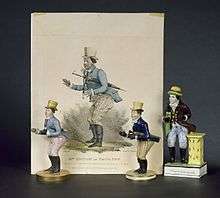Paul Pry (play)
Paul Pry (1825), a farce in three acts, was the most notable play written by 19th-century English playwright John Poole. It premiered in London on 13 September 1825[1] at the Haymarket Theatre and ran 114 performances.[2] The play continued to be popular until the early 1870s.
| Paul Pry | |
|---|---|
| Written by | John Poole |
| Characters | Paul Pry |
| Date premiered | 1825 |
| Original language | English |
| Genre | Farce |
Synopsis
The storyline is centered on a comical, idle, meddlesome and mischievous fellow consumed with curiosity. Unable to mind his own business, he's an interfering busybody who conveniently leaves behind an umbrella everywhere he goes in order to have an excuse to return and eavesdrop. At the end, however, Pry becomes a hero for rescuing papers from a well that incriminate more serious troublemakers.[3][4][5] Cherry Ripe, the 17th-century English folk song to words by the English poet Robert Herrick, is adapted into the play.[2]
Analysis
Rumors abounded that the Pry character was based on the eccentric Thomas ("Tommy") Hill, editor of the Dramatic Mirror, who took daily walks with Poole at Kensington Gardens.[6] However, Poole was quoted in magazines as saying,
"The idea was really suggested by an old invalid lady who lived in a very narrow street, and who amused herself by speculating on the neighbors, and identifying them, as it were, by the sound of the knocks they gave... It was not drawn from an individual, but from a class. I could mention five or six persons who were contributors to the original play."[7]
Productions

In the original 1825 London production, Madame Vestris sang "Cherry Ripe",[2] and John Liston portrayed the title character. His costume included striped pants, Hessian boots, top hat, and tailcoat. Liston's portrayal was so popular that images of Liston as Pry appeared on signs, shops, warehouses, handkerchiefs, and snuff boxes. Porcelain and pearlware factories in Staffordshire, Rockingham, Derby and Worcestershire produced figurines of Liston as Pry. The Liston as Pry image was even stamped on butter.[5][8]
The following year, in 1826, the play was produced in New York City at the Park Theatre, featuring Thomas Hilson.[9] It was first produced in Australia in October 1835 at the Theatre Royal in Sydney, when Joseph Simmons took the title role.[10]
It returned to London's Adelphi Theatre, for the 1851-52 season, featuring Edward Richard Wright and Sarah Woolgar, receiving extensive, positive press comment.[11]
References
- Encyclopaedia britannica; a dictionary of arts, sciences, literature and general information, 11th edition. New York: The Encyclopaedia britannica Co. November 1910. p. 780. OCLC 1303014.
Paul Pry september 1825.
- "Paul Pry 1825". ancestry.com. Retrieved 22 July 2008.
- "American Theater Guide: Paul Pry". answers.com. Retrieved 22 July 2008.
- Brewer, E. Cobham (1898). "Dictionary of Phrase and Fable". bartleby.com. Retrieved 22 July 2008.
- "John Liston as Paul Pry". peopleplayuk.org.uk. Retrieved 22 July 2008.
- "Kensington Gardens". british-history.ac.uk. Retrieved 22 July 2008.
- Frey, Albert R. (1887). Sobriquets and Nicknames. London: Whittaker. p. 267. OCLC 187041119.
John Poole Paul Pry.
- "Papers and Porcelains". folger.edu. Archived from the original on 15 September 2009. Retrieved 22 July 2008.
- "American Theater Guide: Paul Pry". answers.com. Retrieved 22 July 2008.
- "Theatre advertisement, The Sydney Monitor, 24 October 1835, p.3". trove.nla.gov.au. Retrieved 15 May 2015.
- "Seasonal Summary for 1851-1852". emich.edu. Retrieved 22 July 2008.